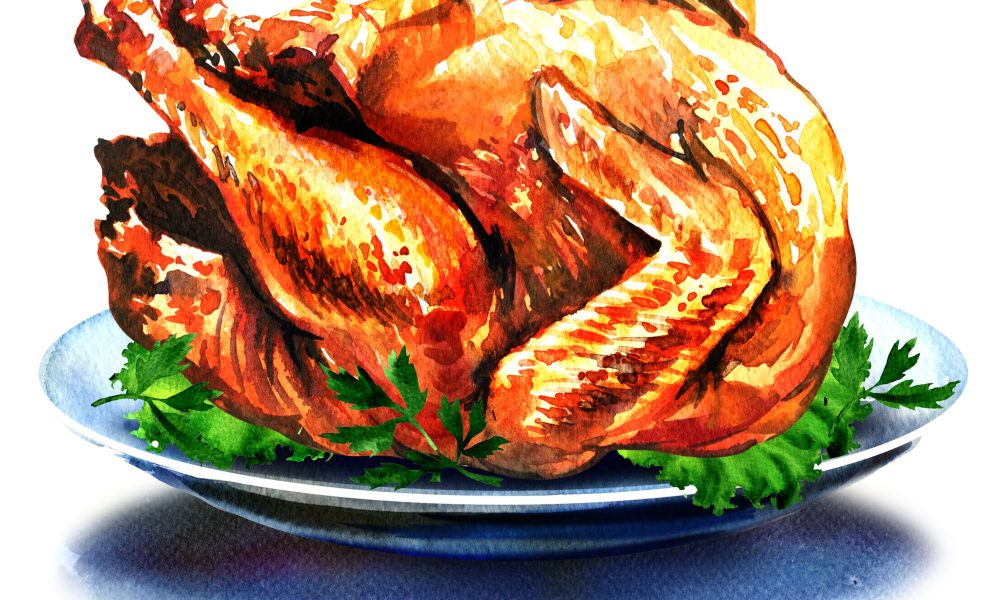Thanksgiving is a time when family and friends gather together and have a feast. Unfortunately, that feast often results in cases of food-borne illness – otherwise known as food poisoning. And turkey is the biggest culprit. Proper food handling can reduce the chance of making someone sick this year.
To Stuff or Not to Stuff
(The bird, not your face. That’s up to you.)
The USDA does not recommend stuffing the turkey before roasting. You can get just as sick from the stuffing itself and the meat if it didn’t get hot enough. Besides, baking it separately gives it a nice crunchy crust. And it’s easier to stuff a casserole dish than a turkey!
Be sure to remove the giblet package from the cavity! If you do happen to forget, check the wrapping. If it’s paper, no harm done. If they’re in plastic though, check the condition of the bag. If the bag does not appear altered in any way, then the bird and innards are probably safe to eat. But if the bag did melt, it likely leached harmful chemicals into the turkey, rendering it unsafe. (Butterball says its giblets come in an oven-safe bag, just for that reason).
If tradition rules in your family and you must stuff, do so safely. Fill the cavity loosely, with a moist mixture. When checking for doneness, test the temperature of the stuffing as well as the bird.
Thawing your turkey
Timing is everything. If you are ordering a fresh turkey, plan on picking it up on Tuesday or Wednesday, not before. Frozen turkeys on the other hand should be purchased far enough ahead to allow for thawing. Allow at least 24 hours for every 4-5 pounds. A16 pound turkey would take 4-5 days to thaw in the refrigerator. You can safely hold the thawed turkey for 1 or 2 days longer before it must be cooked.
Be sure to keep the thawing turkey away from other food. Leave the bird in its package and place it on a pan to catch any liquid that leaks out. If you have a spare refrigerator, that’s a good place for it. Try to hold it on the bottom shelf.
You can speed up the thawing by doing it in cold water. This will require either a deep enough sink or a cooler. Keep in the original packaging and place that in a larger plastic bag, tightly closed. Submerge completely in cold water (straight from the tap is fine, no ice needed). Change the water every half-hour. Figure 30 minutes per pound to thaw. If using an ice chest, keep it in a cool garage or outside.
If your microwave is large enough (or your turkey small enough), it can be used as a last resort. Check the appliance manual for the time. Cook immediately.
Do not attempt to thaw your turkey on the counter or in the garage or anywhere but the above. You can tell when it’s thawed enough when the legs are pliable and the giblet bag comes free of the cavity.
Fowl Cooking
The traditional method is oven roasting. It’s good practice to tie or tuck the wings and legs so they don’t overcook. Roast in a preheated oven at 325 degrees. To keep it from drying out too much, tent it with foil for the first hour or so, then remove so the skin can brown.
Deep-frying is a relatively recent method, but does have its risks. Frying a turkey began with a couple of friends in Cajun country in Louisiana in the 1970s. An article in the food section of the newspaper popularized the idea before long appliances were on the market nation-wide.
Be sure the appliance is on level ground, at least 10 feet away from the house. Keep a fire extinguisher nearby (multi-purpose or class B).
Don’t overfill the pot with oil. One way to gauge the depth is to put the thawed turkey in and fill the kettle with water to cover by 1/2”. Remove the turkey and measure the water.
Monitor the temperature of the oil. If your fryer does not have a thermostat, use a deep-fry thermometer. Wear oven mitts when handling the basket. Make sure the turkey is completely thawed and DRY before immersing it in the hot oil.
Whatever method you use, the turkey is safely cooked when the internal temperature is at least 165 degrees. Our 16 pound turkey would need about 41/2 hours to reach temperature. Test at the innermost part of the thigh and the thickest part of the breast. Even if your turkey came with a pop-up thermometer, you should double-check with a meat thermometer, as the pop-ups do not always work.
Let the bird sit for 20 minutes before carving.
No Bath for the Bird!
Do not wash the turkey once out of the bag. Contrary to popular belief, this will not destroy bacteria, but rather spread it around. You do want to carefully clean your work area after preparing your bird. Don’t forget the sink. Wash all cutting boards, utensils and any dishes used in hot soapy water. For extra safety, disinfect using a mild bleach solution (1 tsp bleach per quart of water).
After the Feast
Thanksgiving dinners can last a long time. Keep an eye on the clock, and be sure to clear away all the hot foods within two hours of cooking. Refrigerate the leftovers in shallow containers to allow for fast and even cooling. Use within 4 days for best quality. Most dishes can also be frozen for 2-6 months. Be sure to reheat any leftovers to 165o before serving. More info: tinyurl.com/34w486ww and 1-888-674-6854.







